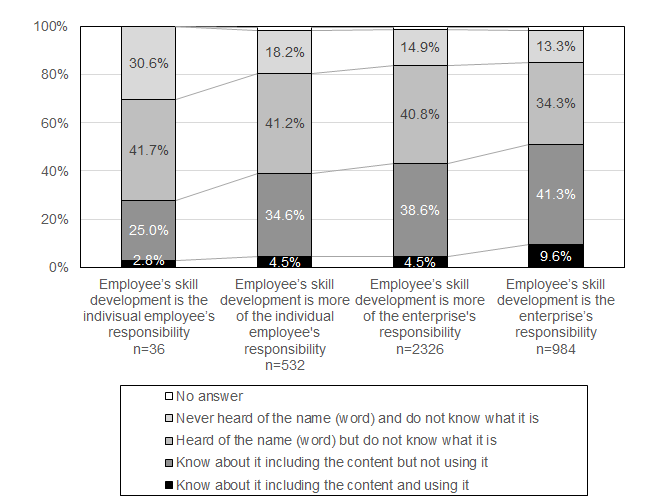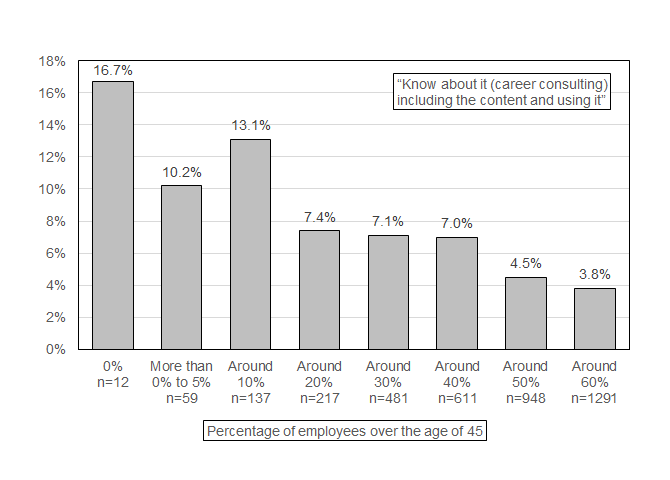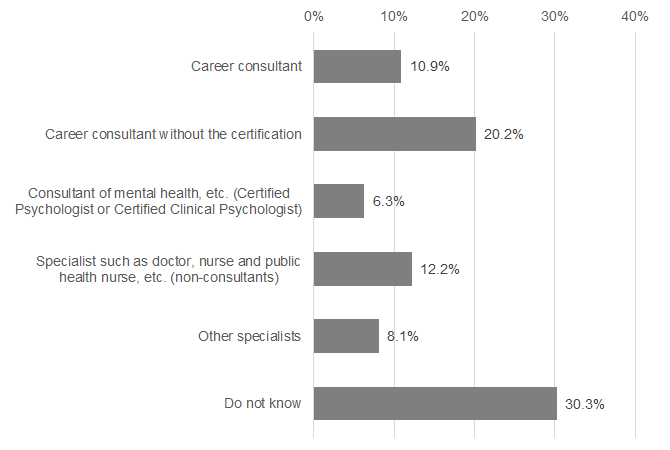JILPT Research Report No.223
Current Situation and Challenges in Introducing Measures for Career Development Support at Enterprises
February 28, 2023
Summary
Research Objective
In considering the further promotion of career consulting at enterprises, it is essential to capture the actual situation of its implementation and collect thoroughly and continuously the evidence related with the system design. Out of such awareness in mind, JILPT conducted a survey to grasp how career consulting is utilized at enterprises. Added to the requests from the Ministry of Health, Labour and Welfare (MHLW), we also examined the various career development support measures at Japanese enterprises, their attribution, management situation and several related matters. The purpose of the survey is to understand the current situation in detail about the enterprise’s skill development and other in-house career development support by especially examining how they are related with the characteristic of the system, costs (budget), and other challenges. This report, while providing overall analysis and suggestions from the survey findings regarding career support and human resource development at enterprises, shows recommendations to the future career consulting from a new perspective.
*In Japanese labor administration, career counseling and guidance are referred to as “career consulting” (or “career consultant” for experts who provide “career consulting”). The term “career consulting” in this report is synonymous with “career counseling” or “career guidance” in countries other than Japan.
Research Method
- (1) Survey target
- Based on the distribution of the industry and the size of offices in the Ministry of Internal Affairs and Communications “Economic Census for Business Activity” (2016), 20,000 enterprises with more than 30 employees throughout the country were randomly selected from enterprises registered in the Tokyo Shoko Research, LTD. database by industry (16 categories) and number of employees (5 categories) excluding agriculture, forestry and fishery and government employees. Some enterprises with less than 30 employees replied (due to a decrease in number of employees after the enterprise is registered in the database), which were utilized for comparison in the analysis.
- (2) Survey Method
- Questionnaires distributed and collected by mail.
- (3) Survey Items
-
- Enterprise attribution (industry, year of foundation, number of employees, development of overseas offices, capitalization, percentage of regular employees, percentage of female regular employees, percentage of employees over the age of 45, etc.)
- Change from 3 years ago (net sales, ordinary income, total personnel costs, number of total employees, number of regular employees, number of newly hired regular employees, number of regular employees hired in their mid-career, turnover rate, retention rate of newly hired regular employees, etc.)
- Career development support measures (corporate in-house skills development plan, skill development promoter, whether the skill development promoter is a qualified career consultant or not, system introduction status of career consulting, self-career dock, the Job Card, etc.)
- Characteristic of skill development (aggressiveness, responsible entities, policy, etc.)
- Human resources management (current situation of human resource development, issues considered important about human resources, business management and budget, etc.)
- Career training program (target group, how to participate, instructor, contents, etc.)
- Career consulting situation (consultation achievement, organization in charge, assignment / number / qualification of persons in charge and their duties, etc.)
- (4) Survey period
- January 2022 (Questionnaires, due January 31, sent out on January 5, and collected those returned by February 1)
- (5) Number of collected responses
- 3,951 collected (collection rate 19.8%). Reminders were previously sent out by mail to all enterprises to reach 15%, the target collection rate.
Key Findings
The followings are the key findings regarding the career development support measures, career training programs, and career consulting:
1. Less than 20% of enterprises formulated the internal business skill development plan for all establishments and less than 10% of enterprises assign the business skill development promoter, and only a few % to around 5% of enterprises understand and use each of the career consulting, self-career dock and job card. It is shown that; i) enterprises that are aggressive in developing the skills of their employees, enterprises that consider a corporate responsibility, and enterprises that have a long-term policy for skills development had higher rates of implementation of various career development support measures (Figure 1), ii) The implementation rate was higher when the number of employees increases as is conventionally known, and furthermore, and iii) “percentage of employees over the age of 45” and “increasing number of new-graduate regular employees in the past 3 years” were cited as factors closely related to the awareness of career consulting and its use (Figure 2). Regarding the rate of career consulting implementation, it should be noted that as this survey asked enterprises about whole company’s initiatives, the rate turned out lower than that in the “Basic Survey of Human Resources Development” which asked establishments about the introduction rate of career consulting.
Figure 1. Awareness and use of career consulting by recognition of responsible entities for skill development

Figure 2. Awareness and use of career consulting by percentage of employees over the age of 45

2. Regarding career training, overall trends are; i) the more the enterprise is active to the skill development, ii) the more the enterprise has the policy for skill development for a mid to long term period, iii) the more numbers of employees the enterprise has, and iv) the less the percentage of employees over the age of 45 is, the enterprises have more trainings for younger employees, more trainings that are mandatory, more trainings for more than 3 days, and more cases in which trainings are partially outsourced to professional instructors. In addition, such enterprises tend to provide various programs as seminars and other forms as well as the follow-ups for all the attendees.
3. Limited number of enterprises have a large-scale or professional career consulting system. As Figure 3 specifically shows; i) more than half of the enterprises leave career consulting operation to the HR department that are not specialized in consultation, ii) more than half of the person in charge of career consulting have other work duties, iii) 40% of enterprises have only one person in charge for consulting operation, and iv) only 10% of the enterprises had an employee/employees with a career consultant certification. Checking the trend further by enterprise attributes, i) the enterprises with a number of employees have more than one person in charge; ii) 30% of the enterprises with more than 1,000 employees had a person/persons with a career consultant certification; iii) the lower the percentage of having employees of over the age of 45, the higher the percentage of having employees with a career consultant certification; iv) the enterprises with more newly graduate employees compared with the time 3 years ago had higher numbers of person in charge of consulting. These above imply that there is room for further environmental improvement even at the enterprises with an in-house career consulting system.
Figure 3. Qualification of the person in charge of career consultation at enterprise with career consulting system (multiple answers)

4. Many enterprises without career consulting system had similar characteristics as follows; i) engaged in the industry of sales or service, ii) relatively few employees, iii) old founding year, iv) high percentage of employees over the age of 45, and vi) declining in the sales, total personnel cost, number of employees, number of mid-career hiring, and the retention rate of new employees with an increasing turnover rate. Among the reason why they were not organizing the career consulting, the highest was “There are no requests from employees.” The most common answer to the question about conditions to introduce the career consulting system was “Will introduce if there is a need among employees,” The most common answer to the question of whether they want to implement a career consulting in the future was “Do not know.” The highest reason was “There are more prioritized issues to be solved other than career consulting.”
Policy Implications
Following 3 points are sorted based on this survey result.
First, the enterprise’s willingness to the skill development of employees is high while the introduction rates of various career development support measures such as the career consulting, Job Card and self-career dock are low, indicating a certain gap. However, there is also a relativity observed between the willingness and actual introduction of the system. The results shown above indicates that there is more room to promote to introduce various career development support measures to the enterprises with motivation of active skill development. It is required to raise the awareness and enlightenment to the enterprises.
Second, through the whole result of the survey, some of enterprises’ attributes were related deeply to the enterprise’s career development support policies. One is the number of employees, which has been well known. The relativity of “the percentage of employees over the age of 45” and “increase of the newly graduated regular employees hiring” is also observed. It can possibly point out that the enterprise’s policies for the career development support is basically for younger employees at present. Emphasizing HRM for the group of younger employees may be useful as a way for the spread of career development support in future. On the other hand, there still remains the major issue going forward how to secure enterprise’s incentive to introduce the career development support for the middle-aged employees.
Third, as a result of analyzing the characteristic of enterprises who do not implement career consulting, the most common reason they indicate was “There are no requests from employees.” The most common condition they indicate for introducing the system is “Will introduce if there is a need among employees.” These results may indicate a simple explanation that there are actually little needs and demands from the employee side, but also a possibility that the employer is not successful to grasp their needs, or a possibility that what employees actually demand and request for consulting does not fit in the in-house career consulting. These issues should be carefully discussed. In particular, it is suggested that the specific requests from workers in general and their career perspectives and awareness that underlie those hopes.
Contents
JILPT Research Report No.223, full text (PDF:6.1MB) [in Japanese]
Category
Human resources management/vocational skills development, Career guidance/job information
Research Period
April 2021–March 2023
Authors
- SHIMOMURA Hideo
- Assistant Research Director, Career Guidance and Job Analysis, JILPT
- KUROSAWA Takumu
- Research director, JILPT (at the time of research)
- KOMODA Takayuki
- Tokyo Medical University, Education IR Center
Related Research
- “Career Counseling at Japanese Companies and Its Intrinsically Japanese Features: Three Functions Seen in the Context of the Japanese Employment System,” Japan Labor Review, vol.13 no.3, Summer 2016 (PDF:344KB)
- JILPT Research Report No.191, Current Status, Effects and Latent Needs of Career Counseling: From Survey Results including Responses from 1,117 Persons with Experience of Counseling (2017)
- “Is Career Counseling Effective?” Japan Labor Issues, vol.2 no.4, January 2018 (PDF:472KB)
- JILPT Research Report No.200, Survey on Activities, Etc. of Nationally Licensed Career Consultants (2018)
- JILPT Research Material Series No.226, Career Consulting Utilizing Job Card: Focusing on the Function as a Career Planning Tool in the Enterprise Area (2020)
- JILPT Research Series No.208, Survey on Workers’ Life and Career Attitudes: Attitudes toward Work, Study and Life (2021)
- JILPT Research Material Series No.250, Research on Career-related Qualification and Digitalization of Career Support in Developed Countries (2022)
JILPT Research Report at a Glance
| To view PDF files, you will need Adobe Acrobat Reader Software installed on your computer.The Adobe Acrobat Reader can be downloaded from this banner. |

